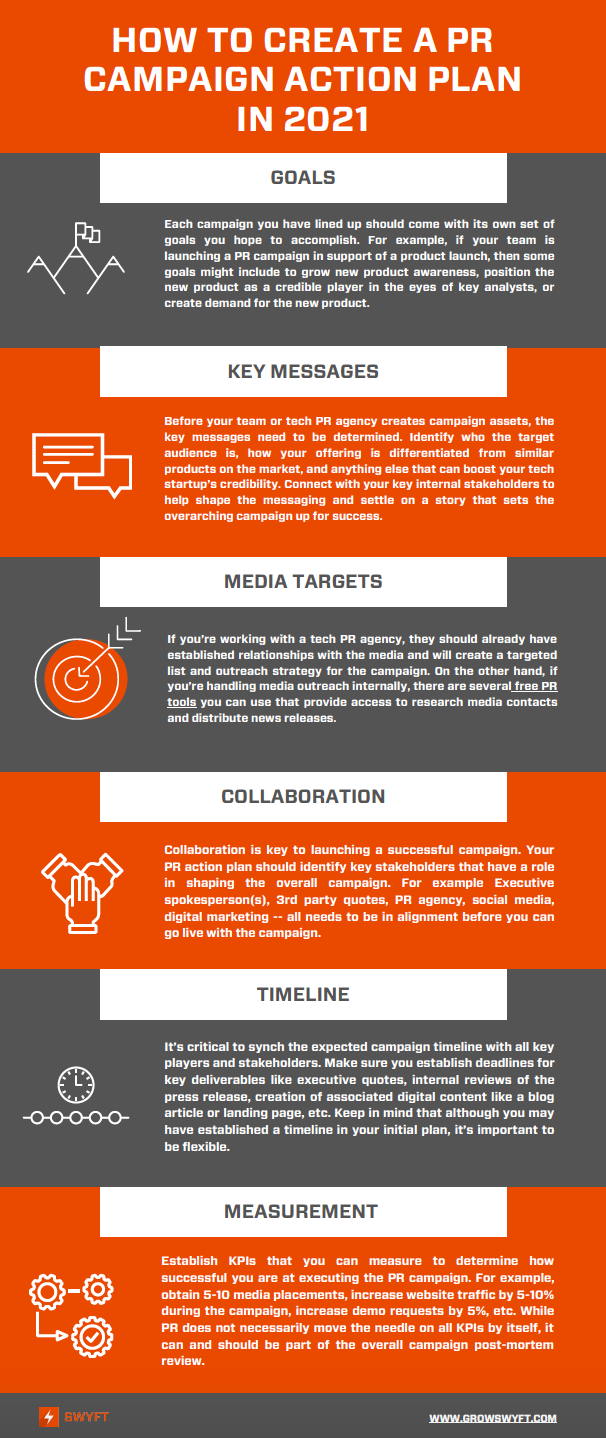With a strong PR plan in place and several product launches or company announcements in the pipeline, you probably have your sights set on a great deal of media coverage for your tech startup in the year ahead.
But in order to land media placements, which effectively increase brand awareness, generate new leads, and build industry credibility, each PR campaign needs to be thoroughly planned and executed.
Follow the steps below to create a PR campaign action plan in 2021.
Goals
Everything your tech startup works on has a goal attached to it, and PR campaigns are no different. Though you should’ve already set long-term goals for the year in your PR plan for 2021, each campaign you have lined up should also come with its own set of goals you hope to accomplish.
For example, if your team is launching a PR campaign in support of a product launch, then some goals might include growing new product awareness, position the new product as a credible player in the eyes of key analysts, or create demand for the new product. Keep these goals top of mind when planning and executing the rest of the PR campaign.
Key Messages
Before your team or tech PR agency can create the assets for the campaign, including the press release, media pitches, or accompanying digital content, the key messages need to be determined.
If the campaign is for a product launch, identify who the product is for, what differentiates it from similar products on the market, and anything else that can boost your tech startup’s credibility. Connect with the key executives, product team, and marketing team to help shape the messaging and settle on a story that positively positions the entire organization and sets the overarching campaign up to successfully meet its goals.
Media Targets
With every campaign, you should have an idea of the media outlets you want to target. This can include mainstream business and tech media like Forbes or TechCrunch, as well as industry publications or influencers. If you’re working with a tech PR agency, they should already have established relationships with the media and will create a targeted list and outreach strategy for the campaign. On the other hand, if you’re handling media outreach internally, there are several free PR tools you can use that provide access to research media contacts and distribute news releases.
Collaboration
Collaboration is key to launching a successful campaign. Your PR action plan should identify key stakeholders that have a role in shaping the overall campaign. Some examples include:
- Executive spokesperson: It’s essential to speak to any key executive(s) involved in the announcement to provide the media with quotes they may use in any reporting they do.
- 3rd party quotes: You may also need quotes from a 3rd party, such as a lead VC investor in a fundraising announcement, to provide additional context the reporter will require for the story.
- PR agency: If you are using a tech PR agency, then you will be working closely with them throughout the campaign. Be sure that your internal PR and marketing activities are in line with their media outreach assets and timeline and that both parties are up to date on campaign activities.
- Digital marketing: Looping in your digital marketing team ensures there is alignment on key messaging, campaign timeline, social media channel support and additional digital content assets.
Timeline
In order to maximize media coverage, it’s key to synch the expected campaign timeline with all key players and stakeholders. For instance, make sure you establish deadlines for key deliverables like executive quotes, internal reviews of the press release, creation of associated digital content like a blog article or landing page, etc.
Keep in mind that although you may have established a timeline in your initial plan, it’s important to be flexible. Product launches and other major announcements don’t always stay on schedule, so leave room in the timeline for delays and be prepared to make adjustments.
Execution
When the time comes to execute the campaign action plan, make sure that everyone involved understands their role. If your tech startup is handling the media outreach internally, make sure there’s a key contact at the organization who can coordinate interviews and answer questions from the media. The last thing you want to do is force a busy journalist to consult LinkedIn for important information on your startup. The results may be incomplete or paint the wrong picture.
If you’re working with a tech PR agency, they will handle the media relations, but it’s important to be available to the PR team and have a communication flow in place so they can easily reach you and ensure proper media coverage.
Make sure your key stakeholders are also on the same page when it comes to execution. Come up with a day-of plan of action across the organization to get everyone involved. For example, if your startup is announcing a recent funding, encourage all employees to share the news on LinkedIn and even Twitter. Company-wide involvement can help amplify the news and reach a much wider network than if only a few individuals in marketing can.
Measurement
Prior to launching the campaign, make sure to establish several KPIs that you can measure to determine how successful you are at executing the PR campaign. Some objectives might include to obtain 5-10 media placements, increase website traffic by 5-10% during the campaign, support 10% increase in demo requests, etc. While PR does not necessarily move the needle on all KPIs by itself, it can and should be part of the overall campaign post-mortem review.


